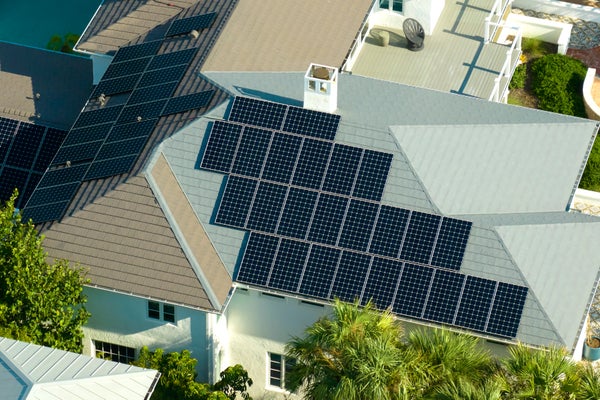CLIMATEWIRE | It seems almost too good to be true.
But the Energy Department says one step by states would help the United States reduce future carbon emissions by nearly 2 billion metric tons and cut $180 billion from the country's collective energy bill over 30 years. And the move needs no new technology, equipment, infrastructure or vehicles and would be the equivalent of removing 445 million gasoline-powered cars from the road over 30 years.
What's required is for states to force new buildings to meet stronger energy standards that reduce consumption.
On supporting science journalism
If you're enjoying this article, consider supporting our award-winning journalism by subscribing. By purchasing a subscription you are helping to ensure the future of impactful stories about the discoveries and ideas shaping our world today.
The Energy Department is touting the benefits of this change in an unprecedented campaign that urges states to make buildings more climate-friendly by adopting new energy codes.
The campaign is unusual because DOE is offering states millions of dollars each through a new energy-codes program. DOE also has produced data showing the amount in energy bills and emissions that each state would drop by adopting up-to-date energy codes.
The data highlight the unheralded role that state building energy codes play in climate change — and the archaic condition of most state codes.
Arizona could save energy ratepayers in the state $23 billion over 30 years, according to DOE. That’s the equivalent of $8,600 per household.
The state also could cut building emissions by 253 million metric tons in that period. That’s the equivalent of removing 2 million gasoline-powered cars from the road.
Arizona ranks first in projected savings and reductions — both in total and per-capita numbers — in part because its building energy code is more than 14 years old. The code is one of the oldest in the United States.
“Energy codes are pretty behind the times,” said Cherylyn Kelley, manager of building energy codes and policy at the Institute for Market Transformation, a nonprofit focused on building improvement. “There’s an immense amount of opportunity for states to update.”
DOE is offering Arizona $10.5 million — one of the largest state allocations — to help develop, implement and enforce a new energy code. Every state is eligible for several million dollars under a $400-million DOE energy-codes program created by the Inflation Reduction Act of 2022.
A DOE spokesperson said states with older energy codes such as Arizona will see “more efficiency savings” by adopting a new code. States with newer energy codes such as Massachusetts “will see less incremental savings,” the spokesperson said in an email.
Massachusetts is projected to save just $284 million through a code update. That move also would reduce building emissions by 1 million metric tons over 30 years.
The Inflation Reduction Act along with the bipartisan infrastructure law created several programs aimed at improving state energy codes and reducing building emissions. Buildings produce 30 percent of total U.S. greenhouse gas emissions, according to EPA.
“It’s unprecedented. It’s an immense amount of money,” Kelley said of the Biden administration's efforts to address climate change through building code updates.
Yet the funding comes amid growing resistance to improving energy codes and other building standards.
The Republican-controlled North Carolina legislature in August blocked an effort by Democratic Gov. Roy Cooper to strengthen the state’s energy codes. In June, U.S. House Republicans sought to defundthe new DOE energy-code program.
“It’s a pretty political process,” Kelley said, noting that home builders have lobbied effectively against updated codes in some state legislatures.
DOE records show that in 24 states, the building energy code for residential buildings was written before 2010. Twelve states use pre-2010 codes for commercial buildings.
Homes built under new energy codes are 40 percent more efficient than homes built under codes written 15 years ago, DOE says.
States typically adopt model energy codes written by large nonprofit groups. The International Code Council writes the code for residential buildings. The American Society of Heating, Refrigerating and Air-Conditioning Engineers, known as ASHRAE, writes energy codes for commercial buildings.
Both organizations produce new codes every three years. But U.S. states are slow to adopt the updates.
Only five states have the most up-to-date residential codes, published in 2021, according to DOE. Ten states have up-to-date commercial codes.
In addition, eight states do not have a statewide energy code, which leaves any requirements to counties and municipalities.
“It costs money and time to update to new codes,” Kelley said. “There are additional costs with adhering with new codes and getting the workforce up to date.”
The DOE created a formula based in part on population and potential savings to determine how much money each state can receive from the new grant program.
The allocations range from $3.7 million for Montana to nearly $18 million for California.
But states must apply to collect their share, which raises the possibility that some will forgo their allocation. States may apply over the next two years.
E&E News reported recently that several states had not bothered to apply for millions of dollars of guaranteed funding from a federal program that helps build climate resilience.
Republican Gov. Ron DeSantis of Florida has spurned tens of millions of dollars is new federal funding from several programs to improve energy efficiency and develop renewable energy sources. DeSantis is seeking the 2024 Republican presidential nomination.
DOE’s state-by-state data on emissions reductions and energy savings aim in part to encourage states to apply for their share of the $400 million.
“It’s extremely useful data, and it helps a lot to have something to point to,” Kelley said. “DOE has done everything in their power to provide a carrot.”
Reprinted from E&E News with permission from POLITICO, LLC. Copyright 2023. E&E News provides essential news for energy and environment professionals.
